Students must practice this TS Intermediate Maths 2A Solutions Chapter 6 Binomial Theorem Ex 6(a) to find a better approach to solving the problems.
TS Inter 2nd Year Maths 2A Solutions Chapter 6 Binomial Theorem Ex 6(a)
I.
Question 1.
Expand the following using binomial theorem.
i) (4x + 5y)5
ii) \(\left(\frac{2}{3} x+\frac{7}{4} y\right)^5\)
iii) \(\left(\frac{2 p}{5}-\frac{3 q}{7}\right)^6\)
iv) (3x + x – x2)4
Solution:
i) we know that
(x + a)n = \({ }^{\mathrm{n}} \mathrm{C}_0\) xn + \({ }^n C_1\) xn-1 a + \({ }^n C_2\) xn-2 a2 + ……………. + \({ }^n C_r\) + \({ }^n C_n\)
∴ (4x + 5y)7 = \({ }^7 \mathrm{C}_0\) (4x)7 + \({ }^7 \mathrm{C}_1\) (4x)6 (5y) + \({ }^7 \mathrm{C}_2\) (4x)5 (5y)2 + \({ }^7 \mathrm{C}_3\) (4x)4 (5y)3 + \({ }^7 \mathrm{C}_4\) (4x)3 (5y)4 + \({ }^7 \mathrm{C}_5\) (4x)2 (5y)5 + \({ }^7 \mathrm{C}_6\) (4x) (5y)6 + \({ }^7 \mathrm{C}_7\) (5y)7
= \(\sum_{r=0}^7{ }^7 C_r\) . (4x)7-r . (5y)r.
ii) We know that
(x + a)n = \({ }^{\mathrm{n}} \mathrm{C}_0\) xn + \({ }^n C_1\) xn-1 a + \({ }^n C_2\) xn-2 a2 + ……………. + \({ }^n C_r\) + \({ }^n C_n\)
\(\left(\frac{2}{3} x+\frac{7}{4} y\right)^5\) = \({ }^5 C_0\left(\frac{2}{3} x\right)^5+{ }^5 C_1\left(\frac{2}{3} x\right)^4\left(\frac{7}{4} y\right)+{ }^5 C_2\left(\frac{2}{3} x\right)^3\left(\frac{7}{4} y\right)^2 +{ }^5 C_3\left(\frac{2}{3} x\right)^3\left(\frac{7}{4} y\right)^3\) + \({ }^5 C_4\left(\frac{2}{3} x\right)\left(\frac{7}{4} y\right)^4+{ }^5 C_5\left(\frac{7}{4} y\right)^5\)
= \(\sum_{r=0}^5{ }^5 C_r \cdot\left(\frac{2}{3} x\right)^{5-r} \cdot\left(\frac{7}{4} y\right)^r\)
![]()
iii) We know that
(x + a)n = \({ }^{\mathrm{n}} \mathrm{C}_0\) xn + \({ }^n C_1\) xn-1 a + \({ }^n C_2\) xn-2 a2 + ……………. + \({ }^n C_r\) + \({ }^n C_n\)
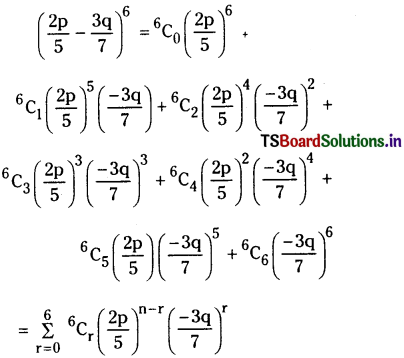
iv) We know that
(3 + x – x2)4 = [3 + x (1 – x)]4
(x + a)n = \({ }^{\mathrm{n}} \mathrm{C}_0\) xn + \({ }^n C_1\) xn-1 a + \({ }^n C_2\) xn-2 a2 + ……………. + \({ }^n C_r\) + \({ }^n C_n\)
∴ [3 + x (1 – x)]4 = \({ }^4 C_0\) 34 + \({ }^4 C_1\)33x (1 – x + \({ }^4 C_2\) 32x2 (1 – x)2 + \({ }^4 C_3\) 3x3 (1 – x)3 + \({ }^4 C_4\) x4 (1 – x)4
= 81 + 108x (1 – x) + 54x2 (1 – 2x + x2) + 12x3 (1 – 3x + 3x2 – x3) + x4 (1 – 4x + 6x2 – 4x3 + x5
= 81 + 108x – 54x2 – 96x3 + 19x4 + 32x5 – 6x6 – 4x7 + x8.
Question 2.
Write down and simplify
i) 6th term in \(\left(\frac{2 x}{3}+\frac{3 y}{2}\right)^y\)
ii) 7th term in (3x – 4y)10
iii) 10th term \(\left(\frac{3 p}{4}-5 q\right)^{14}\)
iv) rth term in \(\left(\frac{3 a}{5}+\frac{5 b}{7}\right)^8\) (1 ≤ r ≤ 9).
Solution:
i) r + 1th term n the expansion of (x + a)n is given by
Tr+1 = \({ }^n C_r\) . xn-r . ar
∴ 6th term in the expansion of \(\left(\frac{2 x}{3}+\frac{3 y}{2}\right)^9\) is given by
T6 = \({ }^9 C_5 \cdot\left(\frac{2 x}{3}\right)^4 \cdot\left(\frac{3 y}{2}\right)^5\)
= 189 . x4 . y5
ii) (r + 1)th term in the expansion of (x + a)n is given by
Tr+1 = \({ }^n C_r\) . xn-r . ar
7th term In the expansion of (3x – 4y)10 is given by
T7 = \({ }^{10} \mathrm{C}_6\) (3x)4 (- 4y)6
= 280 . 125 x4 y6.
iii) (r + 1)th term in the expansion of (x + a)n is given by
Tr+1 = \({ }^n C_r\) . xn-r . ar
10th term in the expansion of \(\left(\frac{3 p}{4}-5 q\right)^{14}\) is given by
T10 = \({ }^{14} \mathrm{C}_9\left(\frac{3 p}{4}\right)^5\) (- 5q)9
= \(\frac{-(2002) \cdot 3^5 \cdot 5^9}{4^5}\) . p5 . q9.
iv) (r + )th term in the expansion of (x + a)n is given by
Tr+1 = \({ }^n C_r\) . xn-r . ar
∴ rth term in the expansion of \(\left(\frac{3 a}{5}+\frac{5 b}{7}\right)^8\) is given by
Tr = \({ }^8 C_{r-1}\left(\frac{3 a}{5}\right)^{9-r}\left(\frac{5 b}{7}\right)^{r-1}\).
![]()
Question 3.
Find the number of terms in the expansion of
i) \(\left(\frac{3 a}{4}+\frac{b}{2}\right)^9\)
ii) (3p + 4q)14
iii) (2x + 3y + z)7
Solution:
1) The expansion of (x + a)n contains (n + 1) terms.
∴ Expansion of \(\left(\frac{3 a}{4}+\frac{b}{2}\right)^9\) contains 10 terms.
ii) The expansion of (x + a)n contains (n + 1) terms.
∴ Expansion of (3p + 4q)14 contains 15 terms.
iii) Number of terms in the expansion of
(a + b + c)n = \(\frac{(n+1)(n+2)}{2}\)
∴ Expansion oF (2x + + z)7 contains \(\frac{(7+1)(7+2)}{2}\) = 36 terms.
Question 4.
Find the numerically greatest term(s) in the expansion of coefficients in (4x – 7y)49 + (4x + 7y)49.
Solution:
We know that
(4x – 7y)49 = \({ }^{49} \mathrm{C}_0\) (4x)49 – \({ }^{49} \mathrm{C}_1\)(4x)48 (7y) + \({ }^{49} \mathrm{C}_2\) (4x)47 (7y)2 – \({ }^{49} \mathrm{C}_3\) (4x)46 (7y)3 + ……………. + \({ }^{49} \mathrm{C}_49\) (7y)49 ………….(1)
(4x + 7y)49 = \({ }^{49} \mathrm{C}_0\) (4x)49 + \({ }^{49} \mathrm{C}_1\)(4x)48 (7y) + \({ }^{49} \mathrm{C}_2\) (4x)47 (7y)2 + \({ }^{49} \mathrm{C}_3\) (4x)46 (7y)3 + ……………. + \({ }^{49} \mathrm{C}_49\) (7y)49 ………….(2)
(1) + (2)
(4x – 7y)49 + (4x + 7y)49 = 2[\({ }^{49} \mathrm{C}_0\) (4x)49 + \({ }^{49} \mathrm{C}_2\) (4x)47 (7y)2 + \({ }^{49} \mathrm{C}_4\) (4x)45 (7y)4 + ………….. + \({ }^{49} \mathrm{C}_48\) (4x) (7y)48]
which contains 25 non-zero coefficients.
![]()
Question 5.
Find the sum of last 20 coefficients in the expansion of (1 + x)39.
Solution:
The last 20 coeffIcients in the expansion of (1 + x)39 are \({ }^{39} \mathrm{C}_{20},{ }^{39} \mathrm{C}_{21}, \ldots \ldots \ldots,{ }^{39} \mathrm{C}_{39}\)
We know that
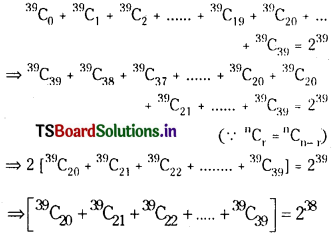
∴ The sum of last 20 coefficients in expansion of (1 + x)39 is 238.
Question 6.
If A and B are coefficients of xn in the expansion of (1 + x)2n and (1 + x)2n – 1 respectively, then find the value of \(\frac{A}{B}\).
Solution:
Coefficient of xn in the expansion of (1 + x)2n is \({ }^{2 n} C_n\).
Coefficient of xn in the expansion of (1 + x)2n – 1 is \({ }^{2 n – 1} C_n\)
∴ A = \({ }^{2 n} C_n\) and B = \({ }^{2 n – 1} C_n\).
∴ \(\frac{A}{B}=\frac{{ }^{2 n} C_n}{2 n-1}=\frac{\frac{2 n !}{n ! n !}}{\frac{(2 n-1) !}{(n-1) ! \cdot n !}}\)
\(\frac{2 n !}{(2 n-1) ! n !} \cdot(n-1) !=\frac{2 n}{n}\)
\(\frac{A}{B}\) = 2.
![]()
II.
Question 1.
Find the coefficient of
i) x-6 in \(\left(3 x-\frac{4}{x}\right)^{10}\)
ii) x11 in \(\left(2 x^2+\frac{3}{x^3}\right)^{13}\)
iii) x2 in \(\left(7 x^3-\frac{2}{x^2}\right)^9\)
iv) x-7 in \(\left(\frac{2 x^2}{3}-\frac{5}{4 x^5}\right)^7\)
Solution:
i) General term in the expansion of (x + a)n is
Tr+1 = \({ }^{\mathrm{n}} \mathrm{C}_{\mathrm{r}}\) . xn-r . ar
(r + 1)th term in the expansion of \(\left(3 x-\frac{4}{x}\right)^{10}\) is
Tr+1 = \({ }^{10} \mathrm{C}_{\mathrm{r}}\) . (3x)10-r . (\(\frac{-4}{x}\))r
Tr+1 = \({ }^{10} \mathrm{C}_{\mathrm{r}}\) . (3)10-r . (- 4)r . x10-2r.
for coefficient of x-6, 10 – 2r = – 6
⇒ 2r = 16
⇒ r = 8.
∴ Coefficient of x-6 is \({ }^{10} \mathrm{C}_8\) . 310-8 . (- 4)8 = 405 × 48.
ii) General term in the expansion of (x + a)n is
Tr+1 = \({ }^{\mathrm{n}} \mathrm{C}_{\mathrm{r}}\) . xn-r . ar
(r + 1)th term in the expansion of \(\left(2 x^2+\frac{3}{x^3}\right)^{13}\) is
Tr+1 = \({ }^{13} C_r \cdot\left(2 x^2\right)^{13-r} \cdot\left(\frac{3}{x^3}\right)^r\)
Tr+1 = \({ }^{13} C_r \) . 213-r . 3r . x26-5r
For coefficients of x11, 26 – 5r = 11
⇒ 5r = 15
⇒ r = 3.
Coefficient of x11 in \(\left(2 x^2+\frac{3}{x^3}\right)^{13}\) is \({ }^{13} C_3 \) . 213-3 . 33
= 286 . 210 . 33.
iii) General term in the expansion of (x + a)n is
Tr+1 = \({ }^{\mathrm{n}} \mathrm{C}_{\mathrm{r}}\) . xn-r . ar
∴ General term in the expansion of \(\left(7 x^3-\frac{2}{x^2}\right)^9\) is
Tr+1 = \({ }^9 C_r \cdot\left(7 x^3\right)^{9-r}\left(\frac{-2}{x^2}\right)^r\)
= \({ }^9 C_r\) 79-r (- 2)r . x27-5r
for coefficient of x2, 27 – 5r = 2
⇒ 5r = 25
⇒ r = 5.
∴ Coefficient of x2 is \({ }^9 \mathrm{C}_5\) . 74 . (- 2)5
= – 126 . 74 . 25.
iv) General term in the expansion of (x + a)n is
Tr+1 = \({ }^{\mathrm{n}} \mathrm{C}_{\mathrm{r}}\) . xn-r . ar
General term in the expansion of \(\left(\frac{2 x^2}{3}-\frac{5}{4 x^5}\right)\) is
Tr+1 = \(={ }^7 C_r \cdot\left(\frac{2}{3} x^2\right)^{7-r} \cdot\left(\frac{-5}{4 x^5}\right)^r\)
= \({ }^7 \mathrm{C}_{\mathrm{r}} \cdot\left(\frac{2}{3}\right)^{7-\mathrm{r}}\left(\frac{-5}{4}\right)^{\mathrm{r}} \mathrm{x}^{14-7 \mathrm{r}}\)
For coefficient of x-7, 14 – 7r = – 7
⇒ 7r = 21
⇒ r = 3
∴ Coefficient of x-7 is \({ }^7 C_3 \cdot\left(\frac{2}{3}\right)^4 \cdot \frac{(-5)^3}{4^3}\)
= \(-\frac{35 \times 16 \times 125}{81 \times 64}=\frac{-4375}{324}\).
![]()
Question 2.
Find the term independent of x in the expansion of
i) \(\left(\frac{\sqrt{x}}{3}-\frac{4}{x^2}\right)^{10}\)
ii) \(\left(\frac{3}{\sqrt[3]{x}}+5 \sqrt{x}\right)^{25}\)
iii) \(\left(4 x^3+\frac{7}{x^2}\right)^{14}\)
iv) \(\left(\frac{2 x^2}{5}+\frac{15}{4 x}\right)^9\)
Solution:
i) General term in the expansion of (x + a)n is
Tr+1 = \({ }^{\mathrm{n}} \mathrm{C}_{\mathrm{r}}\) . xn-r . ar
General term in the expansion of \(\left(\frac{\sqrt{x}}{3}-\frac{4}{x^2}\right)^{10}\) is
Tr+1 = \({ }^{10} C_r \cdot\left(\frac{\sqrt{x}}{3}\right)^{10-r} \cdot\left(\frac{-4}{x^2}\right)^r\)
= \({ }^{10} C_r \cdot \frac{x^{\frac{10-r}{2}}}{3^{10-r}} \cdot \frac{(-4)^r}{x^{2 r}}\)
= \({ }^{10} C_r \cdot \frac{(-4)^r}{3^{10-r}} \cdot x^{\frac{10-5 r}{2}}\)
For the independent term (i.e., the coefficient of x0)
put \(\frac{10-5 r}{2}\) = 0
⇒ r = 2.
∴ Term independent of ‘x’ in the expansion is
T3 = \({ }^{10} C_2 \frac{(-4)^2}{3^8} \times x^0=\frac{80}{729}\).
ii) General term in the expansion of (x + a)n is
Tr+1 = \({ }^{\mathrm{n}} \mathrm{C}_{\mathrm{r}}\) . xn-r . ar
General term in the expansion of \(\left(\frac{3}{\sqrt[3]{x}}+5 \sqrt{x}\right)^{25}\) is
Tr+1 = \({ }^{25} C_r\left(\frac{3}{\sqrt[3]{x}}\right)^{25-r} \cdot(5 \sqrt{x})^r\)
= \({ }^{25} C_r\) . 325-r . 5r . x(5r – 50)/6
For the independent term,
(i.e., coefficient of x0)
Put \(\frac{5 r-50}{6}\) = 0
⇒ r = 10.
∴ Term independent of ‘x’ in the expansion is T11 = \({ }^{25} \mathrm{C}_{10}\) . 315 . 510.
![]()
iii) General term in the expansion of (x + a)nis
Tr+1 = \({ }^{\mathrm{n}} \mathrm{C}_{\mathrm{r}}\) . xn-r . ar
General term in the expansion of \(\left(4 x^3+\frac{7}{x^2}\right)^{14}\) is
Tr+1 = \({ }^{14} C_r \cdot\left(4 x^3\right)^{14-r} \cdot\left(\frac{7}{x^2}\right)^r\)
= \({ }^{14} C_r\) . 414-r . 7r . x42-5r.
For the independent term, (i.e., coefficient of x0)
Put 42 – 5r = 0
which is impossible as ‘r’ is integer.
∴ Term independent of ‘x in the expansion is ‘0’.
iv) General term in the expansion of (x + a)nis
Tr+1 = \({ }^{\mathrm{n}} \mathrm{C}_{\mathrm{r}}\) . xn-r . ar
General term in the expansion of \(\left(\frac{2 x^2}{5}+\frac{15}{4 x}\right)^9\) is
Tr+1 = \({ }^9 C_r\left(\frac{2 x^2}{5}\right)^{9-r} \cdot\left(\frac{15}{4 x}\right)^r\)
= \({ }^9 \mathrm{C}_{\mathrm{r}}\left(\frac{2}{5}\right)^{9-\mathrm{r}} \cdot\left(\frac{15}{4}\right)^{\mathrm{r}} \cdot \mathrm{x}^{18-3 \mathrm{r}}\)
For the independent term, (i.e. coefficient of x0)
Put 18 – 3r = 0
⇒ r = 6
Term independent of ‘x’ in the expansion is
T7 = \({ }^9 \mathrm{C}_6 \cdot\left(\frac{2}{5}\right)^3 \cdot\left(\frac{15}{4}\right)^6\)
= \(\frac{3^7 \cdot 5^3 \cdot 7}{2^7}\).
![]()
Question 3.
Find the middle term(s) in the expansion of
i) \(\left(\frac{3 x}{7}-2 y\right)^{10}\)
ii) \(\left(4 a+\frac{3}{2} b\right)^{11}\)
iii) (4x2 + 5x3)17
iv) \(\left(\frac{3}{a^3}+5 a^4\right)^{20}\)
Solution:
i) General term in the expansion of (x + a)nis
Tr+1 = \({ }^{\mathrm{n}} \mathrm{C}_{\mathrm{r}}\) . xn-r . ar
General term in the expansion of \(\left(\frac{3 x}{7}-2 y\right)^{10}\) is
Tr+1 = \({ }^{10} C_{\mathrm{r}} \cdot\left(\frac{3 \mathrm{x}}{7}\right)^{10-\mathrm{r}}(-2 \mathrm{y})^{\mathrm{r}}\)
The expansion has 11 (odd number) terms.
Hence T6 is the only middle term.
Thus r = 5
∴ Middle term in the expansion is
T6 = \(-10 C_5\left(\frac{6}{7}\right)^5\) . x5 . y5.
ii) General term in the expansion of (x + a)nis
Tr+1 = \({ }^{\mathrm{n}} \mathrm{C}_{\mathrm{r}}\) . xn-r . ar
General term in the expansion \(\left(4 a+\frac{3}{2} b\right)^{11}\) is
Tr+1 = \(\)
The expansion has 12 (even numbers) terms.
Hence T6 and T7 are the middle terms.
Thus r = 5 and r = 6
when r = 5,
T6 = \({ }^{11} C_5 \cdot(4 a)^6 \cdot\left(\frac{3}{2} b\right)^5\)
= 77 × 28 . 36 . a6 . b5.
when r = 6,
T7 = \({ }^{11} C_6(4 a)^5 \cdot\left(\frac{3}{2} b\right)^6\)
= 77 × 25 . 37 . a5 . b6.
![]()
iii) General term in the expansion of (x + a)nis
Tr+1 = \({ }^{\mathrm{n}} \mathrm{C}_{\mathrm{r}}\) . xn-r . ar
General term in the expansion of (4x2 + 5x3)17 is
Tr+1 = \({ }^{17} \mathrm{C}_r\) . (4x2)17-r . (5x3)r.
The expansion has 18 (even number) terms.
Hence T9 and T10 are the middle terms.
Thus r = 8 and r = 9
When r = 8.
T9 = \({ }^{17} \mathrm{C}_8\) . (4x2)9 . (5x3)8
= \({ }^{17} \mathrm{C}_8\) . 49 . 58 . x42
When r = 9,
T10 = \({ }^{17} \mathrm{C}_9\) (4x2)8 (3)9
= \({ }^{17} \mathrm{C}_9\) . 48 . 59 . x43
iv) General term in the expansion of (x + a)nis
Tr+1 = \({ }^{\mathrm{n}} \mathrm{C}_{\mathrm{r}}\) . xn-r . ar
General term in the expansion of \(\left(\frac{3}{a^3}+5 a^4\right)^{20}\) is
Tr+1 = \({ }^{20} C_r \cdot\left(\frac{3}{a^3}\right)^{20-r} \cdot\left(5 a^4\right)^r\)
The expansion has 21 (odd number) terms. Hence, T11 is the only middle term
Thus r = 10
∴ Middle term in the expansion is
T11 = \({ }^{20} C_{10} \cdot\left(\frac{3}{a^3}\right)^{10} \cdot\left(5 a^4\right)^{10}\)
= \({ }^{20} C_{10}\) . 1510 . a10.
Question 4.
Find the numerically greatest term(s) in the expansion of
i) (4 + 3x)15 when x = \(\frac{7}{2}\).
ii) (3x + 5y)12 when x = \(\frac{1}{2}\), y = \(\frac{4}{3}\)
iii) (4a – 6b)13 when a = 3, b = 5.
iv) (3 + 7x)n when x = \(\frac{4}{5}\), n = 5.
Solution:
i) We know that (4 + 3x)15 = 415 \(\left(1+\frac{3 x}{4}\right)^{15}\)
First we find the numerically greatest term in the expansion of \(\left(1+\frac{3 x}{4}\right)^{15}\)
Let X = \(\frac{3 x}{4}\)
x = \(\frac{7}{2}\), |X| = \(\left|\frac{3}{4} \times \frac{7}{2}\right|=\frac{21}{8}\)
Now \(\frac{(n+1)|X|}{1+|X|}=\frac{16 \times \frac{21}{8}}{1+\frac{21}{8}}=\frac{336}{29}\)
not an integer.
Its integral part m = \(\left[\frac{336}{29}\right]\) = 11.
∴ Tm+1, i.e., T12 is the numerically greatest term in the binomial expansion of \(\left(1+\frac{3 x}{4}\right)^{15}\)
∴ T12 = \({ }^{15} C_{11}\left(\frac{3 x}{4}\right)^{11}\)
= \({ }^{15} \mathrm{C}_{11}\left(\frac{21}{8}\right)^{11}\)
∴ Numerically greatest term in the expansion 01(4 + 3x)15 = \({ }^{15} C_{11}\left(4^{15}\right) \frac{21^{11}}{8^{11}}\)
= \({ }^{15} C_{11} \cdot \frac{21^{11}}{2^3}\).
![]()
ii) We know that
(3x + 5y)12 = (3x)12 . (1 + \(\frac{5 y}{3 x}\))12
First we find the numerically greatest term in the expansion of (1 + \(\frac{5 y}{3 x}\))12
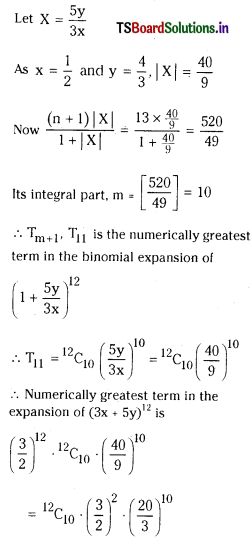
iii) We know that
(4a – 6b)13 = (4a)13 (1 – \(\frac{6 b}{4 a}\))13
First we find the numerically greatest term in the expansion of (1 – \(\frac{6 b}{4 a}\))13
Let X = – \(\frac{6 b}{4 a}\)
As a = 3 and b = 5, |X| = \(\frac{5}{2}\)
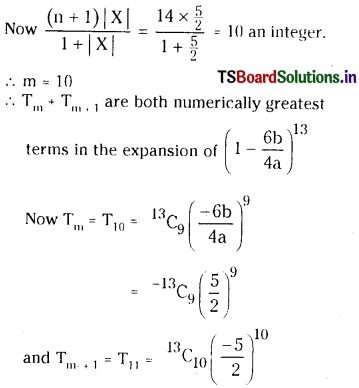
∴ The numerically greatest terms in the expansion of (4a – 6b)13 are T10 and T11.
T10 = – 1213 . 13C9 . \(\left(\frac{5}{2}\right)^9\)
= – 13C9 . (12)4 . (30)9
and T11 = 1210 . 13C10 . \(\left(\frac{5}{2}\right)^10\)
= 143 . 217 . 313 . 510.
iv) We know that (3 + 7x)n = 3n (1 + \(\frac{7}{3}\) x)n
First we find numerically greatest term in the expansion of (1 + \(\frac{7}{3}\) x)n
Let X = \(\frac{7}{3}\) x
As x = \(\frac{4}{5}\), |X| = \(\frac{28}{15}\) and
\(\frac{(n+1)|X|}{1+|X|}=\frac{56}{5}\) and n = 15.
Its integral part,
m = \(\left[\frac{(\mathrm{n}+1)|\mathrm{X}|}{1+|\mathrm{X}|}\right]\) = 11
∴ Tm+1 i.e., T12 is numerically greatest term in the expansion of (1 + \(\frac{7}{3}\) x)n
T12 = 15C11 . \(\left(\frac{28}{15}\right)^{11}\)
∴ The numerically greatest terms in the expansion of (3 + 7x)n is
T12 = 315 . 15C11 . \(\left(\frac{28}{15}\right)^{11}\)
= 15C11 . \(\left(\frac{28}{5}\right)^{11}\) . 34.
![]()
Question 5.
Prove the following:
i) 2 . C0 + 5 . C1 + 8. C2 + ……………. + (3n + 2) Cn = (3n + 4) 2n-1
ii) C0 – 4 C1 + 7 . C2 – 10 . C3 + ……………. = 0,
if n is an even positive Integer.
iii) \(\frac{C_1}{2}+\frac{C_3}{4}+\frac{C_5}{6}+\frac{C_7}{8}+\ldots \ldots=\frac{2^n-1}{n+1}\)
iv) \(C_0+\frac{3}{2} \cdot C_1+\frac{9}{3} \cdot C_2+\frac{27}{4} \cdot C_3+\ldots \ldots+\frac{3^n}{n+1} C_n=\frac{4^{n+1}-1}{3(n+1)}\)
v) C0 + 2 . C1 + 4 . C2 + 8 . C3 + ………….. + 2n . Cn = 3n
Solution:
i) We know that
C0 = Cn, C1 = Cn-1, ………… Cr = Cn-r
Let S = 2 . C0 + 5 . C1 + 8 . C2 + ………….. + (3n – 1) . Cn-1 + (3n + 2) Cn ………….(1)
∴ S = (3n + 2) C0 + (3n – 1)C1 + (3n – 4)C2 + …………. + 5 . Cn-1 + 2 . Cn ………….(2)
(1) + (2) ⇒ 2S = (3n + 4) . C0 + (3n + 4) . C1 + (3n + 4) . C2 + …………… (3n + 4) . Cn
= (3n + 4) (C0 + C1 + C2 + …………… + Cn)
⇒ 2S = (3n + 4) . 2n
⇒ S = (3n + 4) . 2n-1
∴ 2 . C0 + 5 . C1 + 8 . C2 + ………… + (3n + 2) . Cn = (3n + 4) . 2n-1
ii) We know that 1, 4, 7, 10, ………… are in A.P.
(n + 1)th term,
Tn+1 = 1 + (n)3 = 3n + 1
∴ C0 – 4 . C1 + 7 . C2 – 10 . C3 + ……….. (n + 1) terms.
= \(\sum_{r=0}^n(-1)^r(3 r+1) C_r\)
= \(3 \sum_{r=0}^n(-1)^r r \cdot C_r+\sum_{r=0}^n(-1)^r \cdot C_r\)
= 3 (0) + 0 = 0
∴ C0 – 4 . C1 + 7 . C2 – 10 . C3 + ……….. = 0.
![]()
iii) Given L.H.S
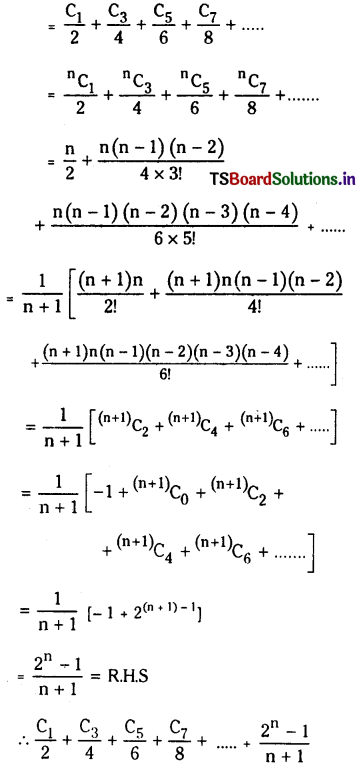
iv) Given L.H.S
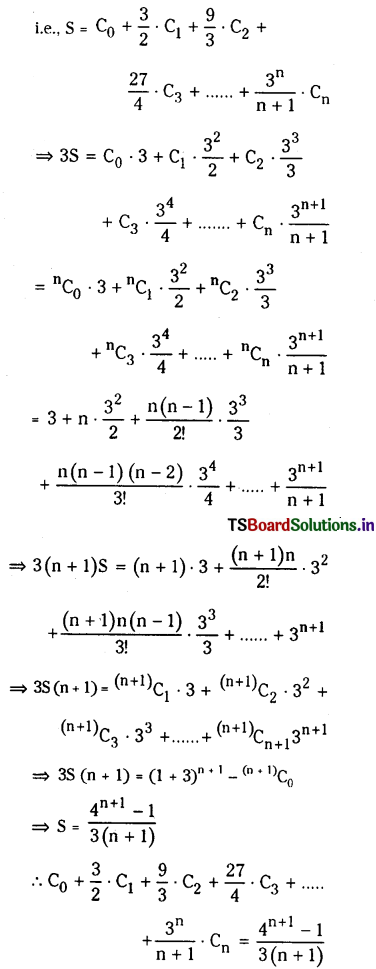
v) L.HS = C0 + 2 . C1 + 4 . C2 + 8 . C3 + ……….. + 2n . Cn
= C0 + C1 . 2 + C2 . 22 + C3 . 23 + ………. + Cn 2n
= (1 + 2)n
= 3n = R.H.S
∴C0 + 2 . C1 + 4 . C2 + 8 . C3 + ……….. + 2n . Cn = 3n.
![]()
Question 6.
Find the sum of the following:
i) \(\frac{{ }^{15} C_1}{{ }^{15} C_0}+2 \frac{{ }^{15} C_2}{{ }^{15} C_1}+3 \frac{{ }^{15} C_3}{{ }^{15} C_2}+\ldots+15 \frac{{ }^{15} C_{15}}{{ }^{15} C_{14}}\)
ii) Cn . C3 + C1 .C4 + C2 . C5 + + …………… + Cn-3 . Cn
iii) 22 C0 + 32 C1 + 42 C2 + …………. + (n + 2)2 Cn
iv) 3C0 + 6C1 + 12C2 + ……………. + 3 . 2n Cn
Solution:
i) We know that
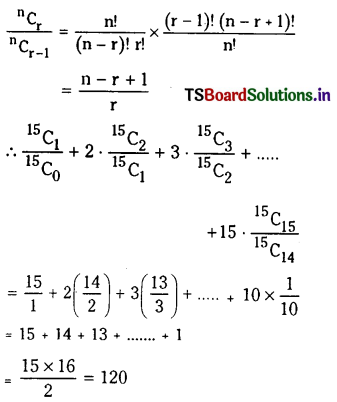
ii) (1 + x)n = C0 + C1x + C2x2 + …………. + Cnxn …………..(1)
(x + 1)n = C0xn + C1xn – 1 + C23xn-2 + …………… + Cn …………….. (2)
(1) x (2) = (1 + x)2n
= (C0 + C1x + C2x2 + ……….. + Cnxn) (C0x + C1xn-1 + C2xn-2 + C3xn-3 + ………….. + Cn]
Comparing coefficients of xn-3 on bothsides,
2nCn-3 = C0 . C3 + C1 . C4 + C2 . C5 + …………. + Cn-3 . Cn
i.e., C0. C3 + C1 . C4 + C2. C5 + …………… + Cn-3 . Cn = 2nCn-3 = 2nCn+3
[∵ nCr = nCn-r].
![]()
iii) 22 C0 + 32 C1 + 42 C2 + …………. + (n + 2)2 Cn
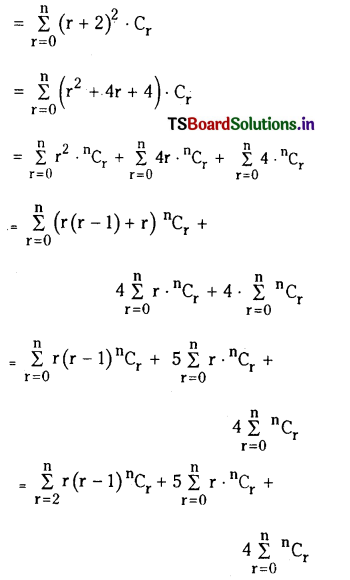
= n (n – 1) 2n-2 + 5 n 2n-1 + 4 (2n)
= 2n-2 [n (n – 1) + 10n + 16]
= (n2 + 9n . 16) 2n-2.
iv) 3 . C0 + 6 . C1 + 12 . C2 + ……………. + 3 . 2n Cn
= \(\sum_{r=0}^n 3 \cdot 2^r \cdot C_r\)
= \(3 \sum_{r=0}^n 2^r \cdot C_r\)
= 3 [1 + C1 (2) + C2 (22) + C3 (23) + …………. + Cn 2n]
= 3 [1 + 2]n
= 3 . 3n
= 3n+1.
![]()
Question 7.
Using binomial theorem prove that 50n – 49n – 1 is divisible by 492 for all positive integers n.
Solution:
We know that,
50n – 49n – 1
= (1 + 49)n – 49n – 1
= [1 + nC1 . 49 + nC2 . 492 + nC3 . 493 + ………… + 49n] – 49n – 1
= nC2 . 492 + nC3 . 493 + …………… + nCn . 49n
= 492 [nC2 + nC3 . 49 + ……….. + nCn . 49n-2]
= 492 (a positive integer)
Hence 50n 49n – 1 is divisible by 492 ∀n ∈ N.
Question 8.
Using binomial theorem prove that 54n + 52n – 1 is divisible by 676 for all positive integers n.
Solution:
We know that, 54n + 52n – 1
= (52)2n + 52n – 1
= (25)2n+ 52n – 1
= (26 – 1)2n+ 52n – 1
= 2nC0 (26)2n – 2nC1 (26)2n-1 + 2nC2 (26)2n-2 + …………. + 2nC2n-2(26)2 – 2nC2n-1 (26) + 2nC2n + 52n – 1
= 262n + 2nC1 (26)2n-1 + 2nC2 (26)2n-2 + …………….. + 2nC2n-2 (26)2
= 262 [262n-2 – 2nC1 262n-3 + 2nC2 262n-4 + ……… + 2nC2n-2]
= 676 (some integer)
∴ 54n + 52n – 1 is divisible by 676, ∀n ∈ N.
![]()
Question 9.
If (1 + x + x2)n = a0 + a1x + a2x2 + ………….. + a2nx2n, then prove that
i) a0 + a1 + a2 + ……….. + a2n = 3n
ii) a0 + a2 + a4 + ………… + a2n = \(\frac{3^n+1}{2}\)
iii) a1 + a3 + a5 + ……………. + a2n-1 = \(\frac{3^n-1}{2}\)
iv) a0 + a3 + a6 + a9 + ………… = 3n-1
Solution:
Given (1 + x + x2)n/sup> = a0 + a1x + a2x2 + ………….. + a2nx2n
i) Subtituting x = 1 in (I), we have
a0 + a1 + a2 + ……….. + a2n = 3n …………. (1)
Substituting x = – 1 in (I), we have
a0 – a1 + a2 + ……….. + a2n = 1 …………….(2)
ii) (1) + (2)
⇒ 2a0 + 2a2 + 2a4 + ……….. + 2a2n = 3n + 1
⇒ a0 + a2 + a4 + ……….. + a2n = \(\frac{3^n+1}{2}\)
iii) (1) – (2)
⇒ 2a1 + 2a3 + 2a5 + ……….. + 2a2n-1 = 3n – 1
⇒ a1 + a3 + a5 + ……….. + a2n-1 = \(\frac{3^n-1}{2}\)
iv) Substituting x = ω, in (1), we have
a0 + a1ω + a2ω2 + ……….. + a2nω2n = 0
(∵ 1 + ω + ω2 = 0)
Substituting x = ω2 in (1), we have
a0 + a1ω2 + a2ω4 + a3ω6 + ……….. + a2nω4n = 0 …………… (4)
(1) + (3) +(4):
3a0 + a1 (1 + ω + ω2) + a2 (1 + ω + ω2) + a3 (1 + ω3 + ω6) + ………… + a2n (1 + ω2n + ω4n) = 3n
⇒ 3a0 + 3a3 + 3a6 + 3a9 + …………. = 3n
(∵ 1 + ω + ω2 = 0 and ω3 = 1)
⇒ a0 + a3 + a6 + a9 + ……….. = 3n-1
![]()
Question 10.
If (1 + x + x2 + x3)7 = b0 + b1x + b2x2 + ……………+ b21 x21, then find the value of
i) b0 + b2 + b4 + ……………. + b20
ii) b1 + b3 + b5 + ……………. + b21
Solution:
Given
(1 + x + x2 + x3)7 = b0 + b1x + b2x2 + ……………+ b21 x21 ……………(1)
Substituting x = 1 in (1),
we get b0 + b1 + b2 + ……………. + b21 = 47 ……….(2)
Substituting x = – 1 in (1),
we get b0 – b1 + b2 + ……………. – b21 = 0 …………… (3)
i) (2) + (3)
⇒ 2b0 + 2b2 + 2b4 + ……………. + b20 = 47
⇒ b0 + b2 + b4 + ……………. + b20 = 213.
ii) (2) – (3)
⇒ 2b1 + 2b3 + 2b5 + ……………. + 2b21 = 47
⇒ b1 + b3 + b5 + ……………. + b21 = 213.
Question 11.
If the coefficients of x11 and x12 in the binomial expansion of \(\left(2+\frac{8 x}{3}\right)^n\) are equal, find n.
Solution:
We know that \(\left(2+\frac{8 x}{3}\right)^n=2^n\left(1+\frac{4 x}{3}\right)^n\)
Coefficient of x11 in the expansion of \(\left(2+\frac{8 x}{3}\right)^n\) is nC11 . 2n . (\(\frac{4}{3}\))11
Coefficient of x12 in the expansion of \(\left(2+\frac{8 x}{3}\right)^n\) is nC12 . 2n . (\(\frac{4}{3}\))12
Given coefficients of x11 and x12 are same
⇒ nC11 . 2n . (\(\frac{4}{3}\))11 = nC12 . 2n . (\(\frac{4}{3}\))12
⇒ \(\frac{n !}{(n-11) ! 11 !}=\frac{n !}{(n-12) ! 12 !}\left(\frac{4}{3}\right)\)
⇒ 12 = (n – 11) \(\frac{4}{3}\)
⇒ 9 = n – 11
⇒ n = 11 + 9 = 20.
![]()
Question 12.
Find the remainder when 22013 is divided by 17.
Solution:
We have 22013
= 2 (22012)
= 2 (24)203
= 2 (16)503
= 2 (17 – 1)203
= 2 [503C0 17503 – 503C1 17502 + 503C2 17501 – ……….. + 503C502 17 – 503C503]
= 2 [503C0 17503 – 503C1 17502 + 503C2 17501 – ……….. + 503C502 17 – 503C503] – 2
= 17m – 2 where ‘m is some integer
∴ 22013 = 17m – 2 (or) 17k + 15
∴ The remainder is – 2 or 15.
Question 13.
If the coefficient of (2r + 4)th term and (3r + 4)th term in the expansion of (1 + x)21 are equal, find r.
Solution:
We know that coefficient of (r + 1)th term of (1 + x)n is nCr.
∴ Coefficient of (2r + 4)th term 0f (1 + x)21 is 21C2r+3
Also coefficient of (3r + 4)th term of (1 +x)21 is 21C3r+3.
Given coefficient of (2r + 4)th term and (3r + 4)th terms in the expansion of (1 + x)21 are equal.
∴ 21C2r+3 = 21C3r+4
∴ Either 2r + 3 = 3r + 3 0r 2r + 3 + 3 = 21
If 2r + 3 = 3r + 3 then r = 0,
If 2r + 3 + 3r = 21 then r = 3.
∴ r = 0 or r = 3.
![]()
III.
Question 1.
If the coefficients of x9, x10, x11 in the expansion of (1 + x)n are in AP. then prove that n2 – 4m + 398 = 0.
Solution:
Coefficient of xr in the expansion of (1 + x)n is nCr.
Given coefficients of x9, x10, x11 in the expansion of (1 + x)n are in A.P., then
2(nC10) = nC9 + nC11
⇒ \(2 \frac{n !}{(n-10) ! 10 !}=\frac{n !}{(n-9) ! 9 !}+\frac{n !}{(n-11) !+11 !}\)
⇒ \(\frac{2}{10(n-10)}=\frac{1}{(n-9)(n-10)}+\frac{1}{11 \times 10}\)
⇒ \(\frac{2}{(n-10) 10}=\frac{110+(n-9)(n-10)}{110(n-9)(n-10)}\)
⇒ 22 (n – 9) = 110 + n2 – 19n + 90
⇒ n2 – 41n + 398 = 0.
Question 2.
If 36, 84, 126 are three successive binomial coefficients in the expansion of (1 + then find n.
Solution:
Let us consider nCr-1, nCr and nCr+1 as three successive binomial coefficients of (1 + xy)n.
i.e., nCr-1 = 36; nCr-1 = 84 and nCr-1 = 126
Consider \(\frac{{ }^{n_C} C_r}{{ }^n C_{r-1}}=\frac{84}{36}\)
⇒ \(\frac{n-r+1}{r}=\frac{7}{3}\)
⇒ 3n + 3 = 10r …………..(1)
Similarly,
\(\frac{{ }^n C_{r+1}}{{ }^n C_r}=\frac{126}{84}\)
⇒ \(\frac{\mathrm{n}-\mathrm{r}}{\mathrm{r}+1}=\frac{3}{2}\)
⇒ 2n = 5r + 3 ………….(2)
⇒ 2n = 5 \(\left(\frac{3 \mathrm{n}+3}{10}\right)\) + 3 (∵ from (1))
⇒ n = 9.
![]()
Question 3.
If the 2nd, 3rd and 4th terms in the expansion of (a + x)n are respectively 240, 720, 1080. find a, x, n.
Solution:
General term in the expansion of (a + x)n is
Tr+1 = \({ }^{\mathrm{n}} \mathrm{C}_{\mathrm{r}}\) . xn-r . ar
∴ 2nd term,T2 = nC1 . an-1 . x …………..(1)
3rd term, T3 = nC2 . an-2 . x2 ………..(2)
4th term, T4 = nC3 . an-3 . x3 …………(3)
Given T2 = 240, T3 = 720, T3 = 1080
From (1) and (2),
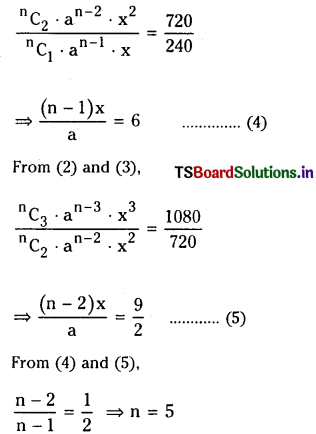
Sub. n = 5 in (1), we get
5 . a4 . x = 240 ………..(6)
Substituting n = 5 in (4), we get x = \(\frac{3 a}{2}\) ………….(7)
Substituting x = \(\frac{3 a}{2}\) in (6),
we get 5 . a4 = 240
⇒ a5 = 32
⇒ a = 2
Substituting in (7), we get x = 3
∴ a = 2; x = 3 and n = 5.
![]()
Question 4.
If the coefficients of rth, (r + 1)th and (r + 2)nd terms in the expansion of (1 + x)n are in A.P., then show that n2 – (4r + 1)n + 4r2 – 2 = 0.
Solution:
We know that, the general term, (r + 1)th term in the expansion of (1 + x)n is
Tr+1 = \({ }^{\mathrm{n}} \mathrm{C}_{\mathrm{r}}\) . xn-r
∴ The coefficients of rth, (r + 1)th and (r + 2)nd terms in the expansion of (1 + x)n are nCr-1, nCr and nCr+1
Given nCr-1, nCr & nCr+1 are in A.P.
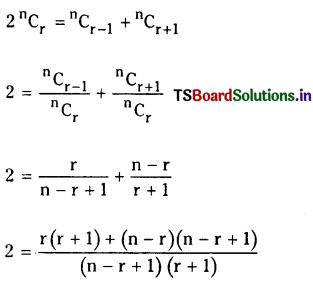
⇒ 2(n – r + 1) (r + 1) = r (r + 1) + (n – r) (n – r + 1)
⇒ 2nr + 2n – 2r2 – 2r + 2r + 2 = r2 + r + n2 – nr + n – nr + r2 + r
⇒ n2 – n (4r + 1) + 4r2 – 2 = 0.
Question 5.
Find the sum of the coefficients of x32 and x-18 in the expansion of (2x3 – \(\frac{3}{x^2}\))14.
Solution:
The general term in (2x3 – \(\frac{3}{x^2}\))14 is
Tr+1 = 14Cr (2x3)14-r (\(\frac{-3}{x^2}\))r
Tr+1 = (- 1)r . 14Cr . 214-r . 3r . x42-5r ………….(1)
For coefficient of x32, put
42 – 5r = 32
⇒ r = 2
Substituting r = 2 in (1), we get
T3 = 14C2 . 212 . 32 . x32
∴ Coefficient of x32 is 14C2 . 212 . 32 ………(2)
For coefficient of x-18, put
42 – 5r = 18
⇒ r=12
Substituting r = 12 in (1), we get
T13 = 14C2 . 22 . 312 . x-18
∴ Coefficient of x-18 is 14C12 . 22 . 312 ………….(3)
Hence sum of the coefficients of x32 and x-18 is
14C2 . 212 . 32 + 14C12 . 22 . 312
= 14C2 . 22 . 32 (210 + 310)
= 91 × 36(210 + 310).
![]()
Question 6.
If P and Q are the sum of odd terms and the sum of even terms respectively in the expansion of (x + a)n then prove that
i) P2 – Q2 = (x2 – a2)n
ii) 4PQ (x + a)2n – (x – a)2n
Solution:
We know that,
(x + a)n = nC0 xn + nC1 xn-1 . a + nC2 xn-2 . a2 + ………….. + nCn-1 x an-1 + nCn an
= (nC0 xn + nC2 xn-2 a2 + nC4 xn-4 a4 + …………) + (nC1 xn-1 a + nC3 xn-3 a3 + nC5 xn-5 a5 + …………..)
∴ (x + a)n = P + Q
∴ Sum of odd terms,
P = nC0 xn + nC2 xn-2 a2 + nC4 xn-4 a4 + …………
Sum of even terms,
Q = nC1 xn-1 a + nC3 xn-3 a3 + nC5 xn-5 a5 + …………..
∴ (x + a)n = P + Q
We know that
(x – a)n = nC0 xn a – nC1 xn-1 a + nC2 xn-2 a12 – nC3 xn-3 a3 + ……………. + nCn (- 1)n an
= (nC0 xn + nC2 xn-2 a2 + nC4 xn-4 a4 + …………) – (nC1 xn-1 a + nC3 xn-3 a3 + nC5 xn-5 a5 + …………..)
⇒ (x – a)n = P – Q
i) P2 – Q2 = (P + Q) (P – Q)
= (x + a)n (x – a)n
⇒ P2 – Q2 = (x2 – a2)n
ii) 4PQ = (P + Q)2 – (P – Q)2
= [(x + a)n]2 – [(x – a)n]2
⇒ 4PQ = (x + a)2n – (x – a)2n
Question 7.
If the coefficients of 4 consecutive terms in the expansion of (1 + x)n are a1, a2, a3, a4 respectively, then show that \(\frac{a_1}{a_1+a_2}+\frac{a_3}{a_3+a_4}=\frac{2 a_2}{a_2+a_3}\)
Solution:
Given a1, a2, a3, a4 are the coefficients of 4 consecutive terms in (1 + x)n respectively.
Let a1 = nCr-1
a2 = nCr
a3 = nCr+1
a4 = nCr+2
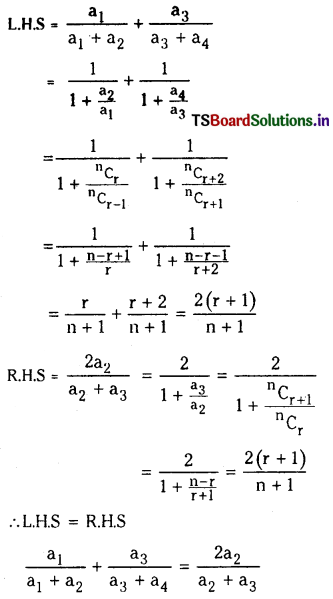
![]()
Question 8.
Prove that (2nC0)2 – (2nC1)2 + (2nC2)2 – (2nC3)2 + ……….. + (2nC2n)2 = (- 1)n 2nCn.
Solution:
We know that
(x + 1)2n = 2nC0 x2n + 2nC1 x2n-1 + 2nC2 x2n-2 + …………… + 2nC2n ……………(1)
(1 – x)2n = 2nC0 – 2nC1 x + 2nC2 x2 – …………… + 2nC2n x2n ……………(2)
From (1) and (2),
(1 – x)2n (1 + x)2n = (2nC0 – 2nC1 x + 2nC2 x2 + ……………… + 2nC2n x2n)
⇒ (1 – x2)2n = [2nC0 x2n + 2nC1 x2n-1 + 2nC2 x2n-2 + …………… + 2nC2n] . [2nC0 – 2nC1 x + 2nC2 x2 + …………… + 2nC2n x2n]
Equating coefficient of x2n on both sides, we get
(- 1)n . 2nCn = (2nC0)2 + ((2nC1)2 + (2nC2)2 – (2nC3)2 + ………….. + (2nC2n)2
Question 9.
Prove that
(C0 + C1) (C1 + C2) (C2 + C3) ………….. (Cn-1 + Cn) = \(\frac{(\mathbf{n}+1)^{\mathbf{n}}}{\mathbf{n} !}\) . C0 . C1 . C2 ………….. Cn.
Solution:
Given L.H.S
(C0 + C1) (C1 + C2) (C2 + C3) ………….. (Cn-1 + Cn)
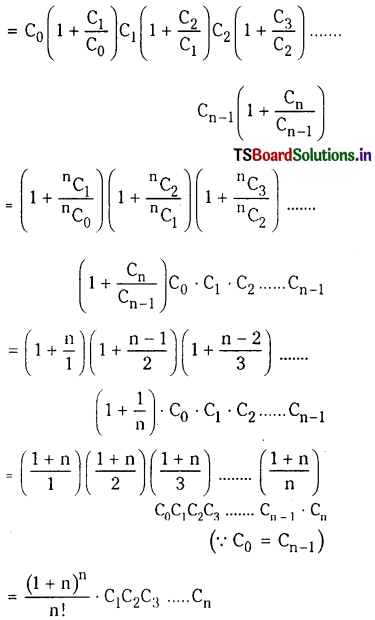
= R.H.S
(C0 + C1) (C1 + C2) (C2 + C3) ………….. (Cn-1 + Cn) = \(\frac{(\mathbf{n}+1)^{\mathbf{n}}}{\mathbf{n} !}\) . C0 . C1 . C2 ………….. Cn.
![]()
Question 10.
Find the term independent of x in (1 + 3)n (1 + \(\frac{1}{3 x}\))n.
Solution:
We know that (1 + 3)n (1 + \(\frac{1}{3 x}\))n = (\(\frac{1}{3 x}\))n (1 + 3x)2n
= \(\frac{1}{3^n \cdot x^n} \sum_{r=0}^{2 n}\left({ }^{2 n} C_r\right)(3 x)^r\)
For the term, independent of x put r = n.
∴ The term independent of x in (1 + 3)n (1 + \(\frac{1}{3 x}\))n is \(\frac{1}{3^n}\) 2nCn . 3n.
Question 11.
Show that the middle term In the expansion of (1 + x)2n is \(\frac{1 \cdot 3 \cdot 5 \ldots \ldots(2 n-1)}{n !}\) (2x)n.
Solution:
The expansion of (1 + x)2n contains 2n + 1 terms.
∴ Middle term is (n + 1)th term
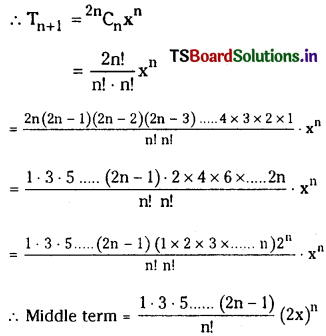
![]()
Question 12.
If (1 + 3x – 2x2)10 = a0 + a1x + a2x2 …………… + a20x20, then prove that
i) a0 + a1 + a2 + …………… + a20 = 210
ii) a0 – a1 + a2 – a3 + …………. + a20 = 410
Solution:
Given
(1 + 3x – 2x2)10 = a0 + a1x + a2x2 …………… + a20x20 …………….(1)
i) Put x = 1, in (1), we get
(1 + 3 – 2)10 = a0 + a1 + a2 + …………… + a20
⇒ a0 + a1 + a2 + …………… + a20 = 210.
ii) Put x – 1 in (1), we get
(1 – 3 – 2)10 = a0 – a1 + a2 – a3 + …………. + a20
a0 – a1 + a2 – a3 + …………. + a20 = 410.
Question 13.
If (3√3 + 5)2n + 1 = x and f = x – [x] (where [x] the integral part of x), find the value of x.f.
Solution:
Given (3√3 + 5)2n + 1 = x
and f = x – [x]
∴ 0 < f < 1
Let us consider F = (3√3 + 5)2n + 1
We know that
5 < 3√3 < 6 = 0 < 3√3 – 5 < 1
⇒ 0 < (3√3 – 5)2n + 1 < 1
⇒ 0 < F < 1
⇒ – 1 < – F < 0
Let x = I + f (where E is an integer)
Now
i + f – F = (3√3 + 5)2n + 1 + (3√3 – 5)2n + 1
= [2n + 1C0 (3√3)2n+1 + 2n + 1C1 (3√3)2n . 5 + 2n + 1C2 (3√3) . 52 + …………..] – [2n + 1C (3√3)2n+1 – 2n + 1C1 (3√3)2n . 5 + 2n + 1C2 (3√3)2n-1 . 52 – …………]
= 2 [2n + 1C1 (3√3) 5 + 2n + 1C3 (3√3)2n-2 53 + …………. + (2n + 1)C(2n+1) (5)2n+1]
= 2k, where k is an integer
∴ I + f – F is an even integer
⇒ f – F is also integer.
∴ (1) + (2)
⇒ – 1 < f – F < 1
⇒ f – F = 0
⇒ f = F
∴ x . f = x . F
= (3√3 + 5)2n + 1 . (3√3 – 5)2n + 1
= (27 – 25)2n + 1
= 22n + 1.
![]()
Question 14.
If R, n are posilve integers, n is odd, 0< F < 1 and if (5√5 + 11) = R + F, then prove that
i) R is an even integer and
ii) (R + F). F = 4n
Solution:
Given R, n are positive integers, 0 < F < 1 and
(5√5 + 11)n = R + F …………….(1)
i) Consider (5√5 – 11)n = f …………….(2)
We know that 11 < 5√5 < 12
⇒ 0 < 5√5 – 11 < 1
⇒0 < (5√5 – 11)n < 1
⇒ 0 < f < 1
⇒ – 1 < – f < 0 ………….(3)
From (1) and (3)
– 1 < F -f < 1 ……………(4)
Also R + F – f
= (5√5 + 11)n – (5√5 – 11)n
= [nC0 (5√5)n + nC1 (5√5)n-1 (11) + nC2 (5√5)n-2 . 112 + nC3 (5√5)n-3 . 113 + ………… + nCn (11)n] – [nC0 (5√5)n – nC1 (5√5)n-1 (11) + nC2 (5√5)n-2 . 112 – nC3 (5√5)n-3 . 113 + ………….. + (- 1)nCn (11)n]
= 2 [nC1 (5√5)n-1 (11) + nC3 (5√5)n-3 (11)3 + ……………]
= 2k, where k is an integer (∵ f is odd)
∴ R + F – f is an even Integer.
⇒ F – f is also an interger. (∵ R is integer)
From (4), we have F – f = 0
⇒ F = f
∴ R is an even Integer.
ii) Now (R + F) . F
= (5√5 + 11)n (5√5 + 11)n
= ((5√5)2 – 112)n = 4n
∴ (R + F) . F = 4n.
Question 15.
If I, n are positive Integers, 0 < f < 1 and if (7 + 4√3) = I + f, then show that
i) I is an odd integer and
ii) (I + f) (I – f) =
Solution:
Given I and n are positve integers.
0 < f < I and (7 + 4√3)n = I + f ………….(1)
i) Let us consider (7 – 4√3)n = F
We know that 6 < 4√3 < 7
⇒ – 7 < – 4√3 < – 6
⇒ 0 < 7 – 4√3 < 1
⇒ 0 < (7 – 4√3)n < 1
⇒ 0 < F < 1
we have 0 < F + f < 2 …………(2)
Now I + f + F = (7 + 4√3)n + (7 – 4√3)n
= [nC0 7n + nC1 7n-1 (4√3) + nC2 7n-2 (4√3)2 + ………….. + nCn (4√3)n] + [nC0 7n – nC1 7n-1 (4√3) + nC2 7n-2 (4√3)2 – ………….. + nCn (- 1)n (4√3)n]]
= 2[nC0 7n + nC2 7n-2 (4√3)2 + nC4 7n-4 (4√3)4 + ……………]
= 2k, where k is an integer.
∴ I + f + F is an even integer.
∴ f + F is also an integer. (∵ I is an integer)
from (2) we have f + F = I ………..(3)
∴ I + I is an even integer
⇒ I is an odd integer.
ii) Also (I + f) (I – f) = (I + f) F
= (7 + 4√3)n (7 – 4√3)n
= (72 – (4√3)2)n = 1.
![]()
Question 16.
If n is a Positive integer, prove that \(\sum_{r=1}^n \mathbf{r}^3 \cdot\left(\frac{{ }^n C_r}{{ }^n C_{r-1}}\right)^2=\frac{n(n+1)^2(n+2)}{12}\).
Solution:
We know that \(\frac{{ }^{{ }^r} C_r}{{ }^n C_{r-1}}=\frac{n-r+1}{r}\)
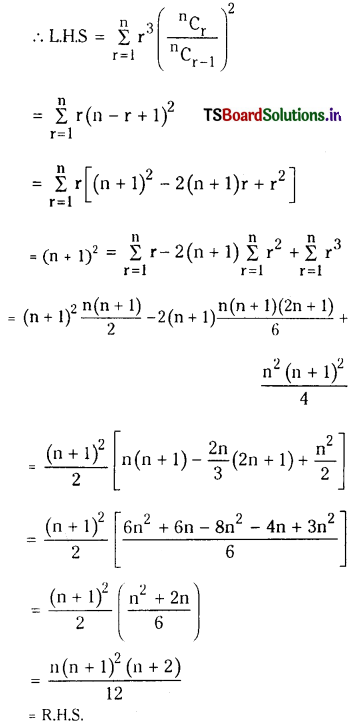
Question 17.
Find the number of irrational terms in the expansion of (51/6 + 21/8)100.
Solution:
Number of terms in the expansion of (51/6 + 21/8)100 are 101.
General term in the expansion of (x + y)n is
Tr+1 = nCr xn-r . yr
∴ General term in the expansion of (51/6 + 21/8)100
Tr+1 = 100Cr . \(\left(5^{\frac{1}{6}}\right)^{100-r} \cdot\left(2^{\frac{1}{8}}\right)^r\)
= 100Cr . \(\cdot 5^{\frac{100-r}{6}} \cdot 2^{\frac{r}{8}}\)
For Tr+1 to be a rational.
Clearly ‘r’ is a multiple of 8 and 100 – r is a multiple of 6
∴ r = 16, 40, 64. 88.
Number of rational terms are 4.
∴ Number of irrational terms are 101 – 4 = 97.